The Pine Processionary Caterpillar is feared by dog owners all over southern Spain, and for good reason. These hairy larvae can easily end your dog’s life. But they can also be dangerous to young children and create severe allergic reactions in adults.
After living 10 years in Andalucia and spending a lot of time outdoors, it still baffles me that so many people don’t know how poisonous these creatures are.
At the same time, dogs die every year because they have stuck their nose where they shouldn’t have, and I talk to people who got an allergic reaction from coming in contact with them.
That’s why I’ll explain everything you need to know about Pine Processionary Caterpillars, when and where you can expect to see them, and what to do if you or your dog gets in direct contact with them.
Disclosure: This post may contain affiliate links. That means that if you make a purchase through one of those links, I will get a small commission at no extra cost to you. As an Amazon Associate, I earn from qualifying purchases.

I’m Linn Haglund, the face behind Andalucia Hiking. I’m an avid hiker and after calling Andalucia home for over 10 years, I’ve covered my share of peaks, ravines, rivers, and valleys across all 8 provinces. I’m here to help you navigate this incredible region with thorough hiking guides, hiking tips, and gear recommendations.
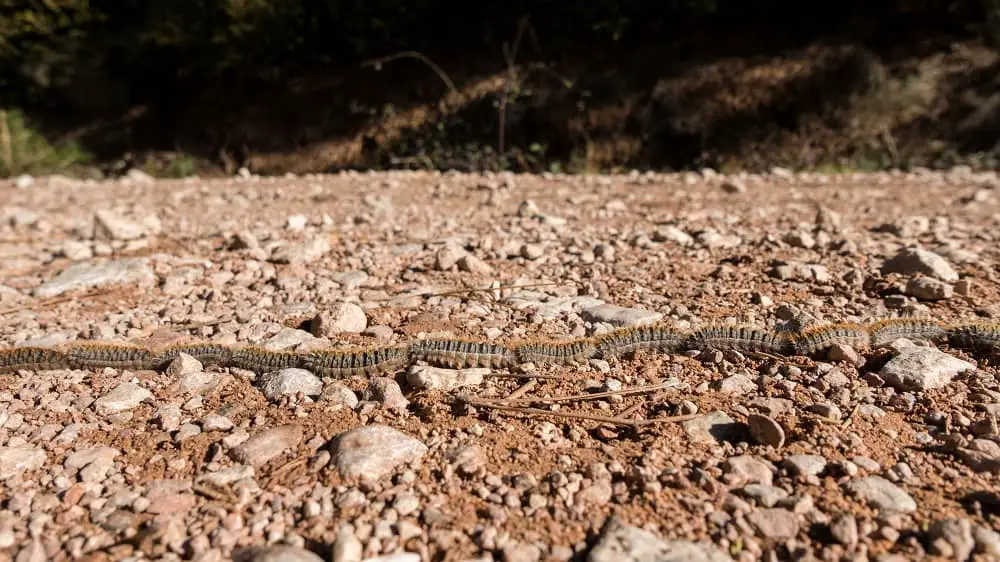
Table of Contents
What are Pine Processionary Caterpillars
Pine Processionary Caterpillars are usually around 3-4 cm long, with a warm yellow, orange, or brown color. Their bodies are covered in millions of hairs which function as tiny poison arrows to protect themselves.
They spend their first living weeks in white spider-web-like nests in pine trees. Once they crawl down to the ground, is where you mostly will see them either still in a crowd regrouping or walking in a line, sometimes up to 2 meters long.
This is why they are called processionary caterpillars. They will walk in a line until they find a suitable place to crawl underground. After a few months underground, they turn into moths and fly out, usually in autumn.
Also known as the pine processionary moth, they will eventually fly up in the pine trees and lay their eggs. Each individual can lay around 300 eggs in a sticky mass which is fastened to a pine needle.
Once the baby caterpillars are born, they build a nest which they use as a base while foraging on the pine trees until they are big enough. Monitoring of pine processionary caterpillars has shown that they travel long distances at night to feed on pine trees far from their nests, even in freezing temperatures.
Once they’re done growing, the life circle starts all over again by crawling down the pine tree and looking for a nice spot in the soil to dig themselves down and form cocoons.
The pine processionary caterpillar doesn’t have many predators, but there are a few bird species that enjoy them for a snack. Luckily for the pine forests, which are suffering when large numbers of pine processionary caterpillars devour their pine trees.
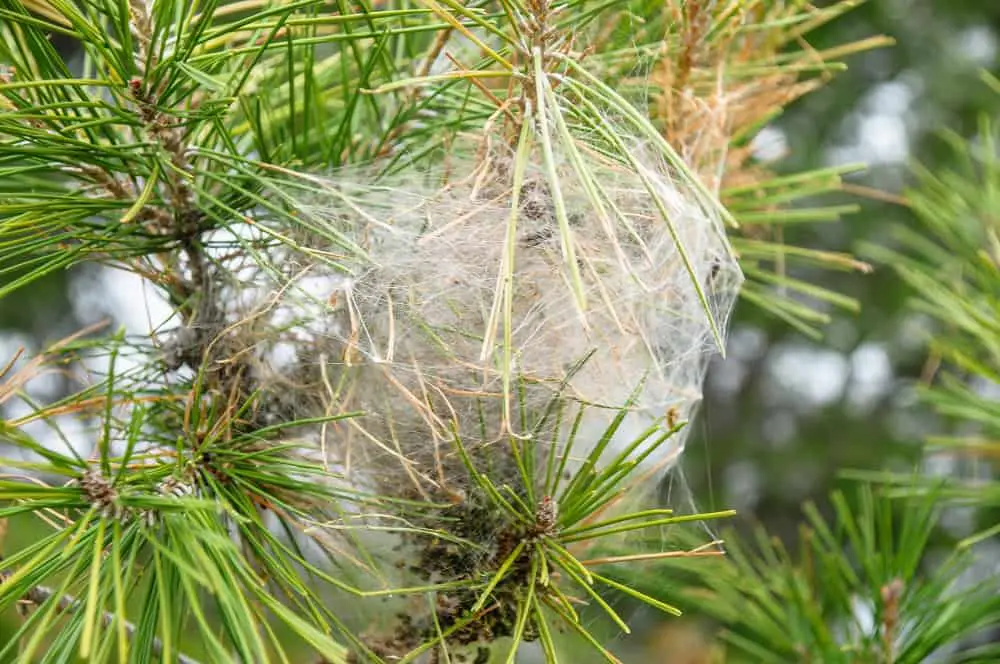
Where can you find processionary caterpillars in Spain
You can mainly find processionary caterpillars in Spain in the southern Mediterranean areas including the islands where ever there are pine trees.
Not only in pine forests, as the pine processionary month even lays eggs in pine trees in inhabited areas like gardens and golf fields.
If you detect nests in your garden, do not try to remove them yourself as it can result in their tiny poisonous hairs flying around and creating more harm than good. Call local authorities or pest control so that you know they get removed in a safe way.

When can you expect to see processionary caterpillars in Andalucia
After the nests are built, it usually takes two to three weeks before the pine processionary caterpillars come out.
Yet, they usually don’t come out if it’s too cold. That’s why you often see them earlier on eg. Costa del Sol where the winter is warmer compared to higher areas in the inland where minus degrees are common at night.
Yet the season for the pine processionary caterpillars to move out from their nest is anywhere between late December to March, usually seen until summer.
Every year I meet surprised hikers with their dogs running around the pine forests on the coast when I mention that I’ve already seen them out on the path in late December or early January.
It seems like people don’t want to accept the fact that they come out this early. Because they’re “meant to come out in February-March”. Sorry to disappoint! That’s not the reality. At least it hasn’t been for the last 8 winters.
Yet, in the colder areas and higher mountains, they often come out later. Though I did see them out at nearly 1800 m of altitude in Sierra de Cazorla last December.
If you’re normally hiking with dogs, you might just want to leave them at home whenever you hike a place with pine trees with nests any time from the end of December and until summer.
If the nests aren’t built yet, it means they haven’t started their foraging yet and you can safely bring your furry friend.
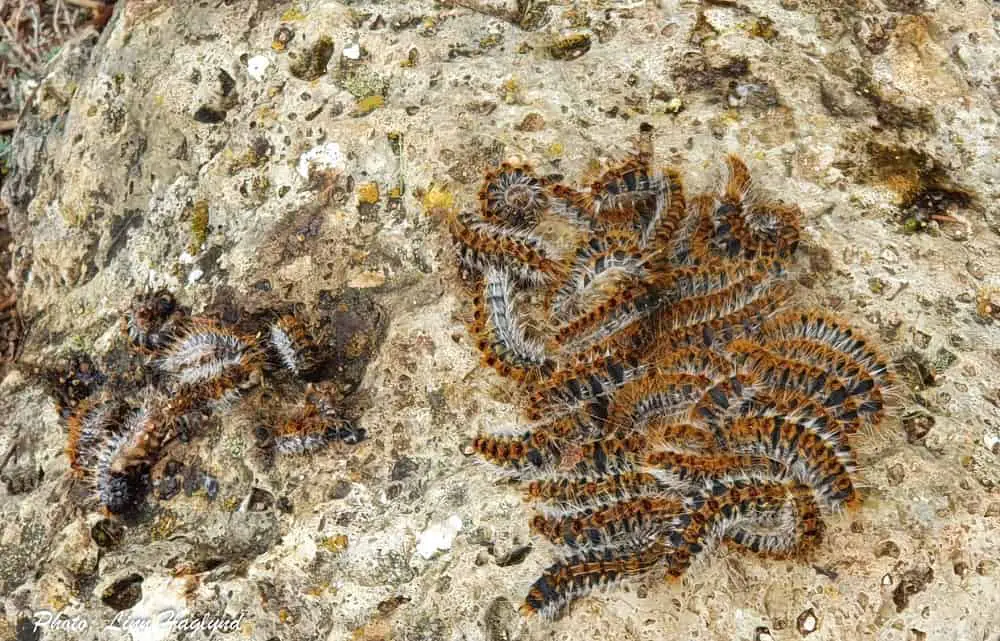
Why are pine processionary caterpillars dangerous?
As I mentioned above, the pine processionary caterpillars are covered in millions of hairs that work like tiny, poisonous arrows. They contain a protein called Thaumetopoein, which in small doses can create a rash that is similar to what you get when stung by a nettle.
When they protect themselves, they dart out these toxic hairs which in turn can get stuck in your skin, eyes, or in your pet’s skin or fur – which they are likely to lick thus transfer to their tongue.
Worth noting is that these hairs are poisonous even after the caterpillars are dead. It’s common to see lines of them run over by cars on the roads, so you need to take care so your pet doesn’t walk on them.
It’s also common that venomous hairs are left behind wherever the caterpillars have passed on the ground. You or your dog could just as well walk in those.
Typical symptoms to look for on your dog – unless you actually witness that it is in touch with the insects:
- small white spots around their mouth and tongue
- drooling
- swollen tongue
- vomiting
- suffocation
- disorientation
You might also notice that your dog is itching or trying to lick off the pain in the affected area intensively.
Common reactions in humans are allergic reactions and respiratory problems, which makes it especially dangerous for small children. When caterpillar hairs are in contact with the eyes, it can even harm your sight.
Some people react mildly, while others have a stronger reaction. It’s not unheard of that people have gotten an arm or a leg blow up to double the size due to an allergic reaction.
The potential danger of pine processionary caterpillars should not be underestimated.
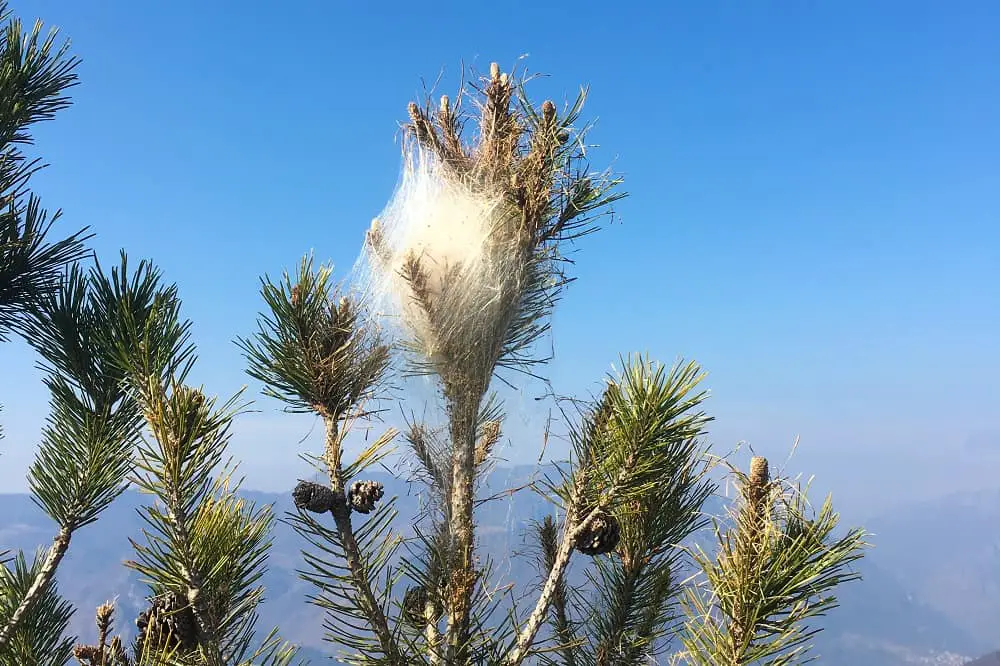
How to protect your dog against pine processionary caterpillars
The only way you can safely protect your dog from pine processionary caterpillars is to avoid taking it to pine forests with nests from the end of December until summer.
However, if you choose to take your dog until you actually see them, or if you live in an area with a lot of pine trees with nests, you can ask your vet for pills to slow down a potential allergic reaction.
Nearly every year, I see pine processionary caterpillars on a hike when I walk with Ayla (my ever faithful furry friend) – very early in the season before I expect to see them.
Whenever this happens, I keep her on a short lead next to my leg and browse the ground while walking so I make sure that she doesn’t walk or stick her snout on any.
I usually wash her paws when we get home too. Not sure if it actually makes a difference to wash her, but I hope it removes any caterpillar hair she might have stepped on so she won’t try to lick them off. I’d rather be safe than sorry.
Another thing to keep in mind, even though you leave your dog at home for the hike, is that if you step on the caterpillars, you will have your shoes full of caterpillar hair. Shoes that you bring home and walk on the same ground as your dog. If your dog gets stung on the paw, there is a big chance it’ll lick it. So clean your shoes too or leave them in a secure place where your dog won’t get in touch with them.
Stepping on the caterpillars can also result in venomous hairs flying in the air which in turn can get stuck on you or anyone around you, including pets.
Hikes in Andalucia without pine trees (click the links for complete hiking guide):
- El Torcal de Antequera (Malaga)
- Ruta de Los Cahorros (Granada)
- Rio Molinos (Almeria)
- Bonales (Huelva)
- Pico El Terril (Seville)
- Pico Chamizo (Malaga)
- Cala de San Pedro (Almeria)
- Loma Pelada (Almeria)
- Rio Majaceite (Cadiz)
- Caldera de Majada Redonda (Almeria)
- Sendero La Molata (Almeria)
- Vereda de la Estrella (Granada)
- Lavaderos de la Reina (Granada)
- Chorreras de Balastar (Malaga)
- Antenas de Aguadulce (Almeria)
- Camorro Alto (Malaga)
- Sendero de Las Arquillas (Malaga)
- La Tiñosa (Cordoba)
- Rio Bailón from Zuheros (Cordoba)
YOU MIGHT ALSO LIKE: Essential tips you need to know about hiking with dogs
What to do if your dog licks on a pine processionary caterpillar
If you have pills given by your vet, make sure you give them to your dog the same moment you realize it has been licking or eating on the caterpillars.
You still need to hurry to the vet as soon as you notice your dog has been in contact with the larvae or notice any of the earlier mentioned symptoms.
Giving this pill is no guarantee that your pet will survive – especially if it eats or lick the caterpillars – but it might buy you a bit more time to reach the vet.
According to my vet, washing the affected area with cold water (which you’ll have with you on a hike anyway) might also help slow down the reaction.
In any case, make sure you get to the closest vet as soon as possible for treatment as the sooner you get there, the better chances your pet has to survive.
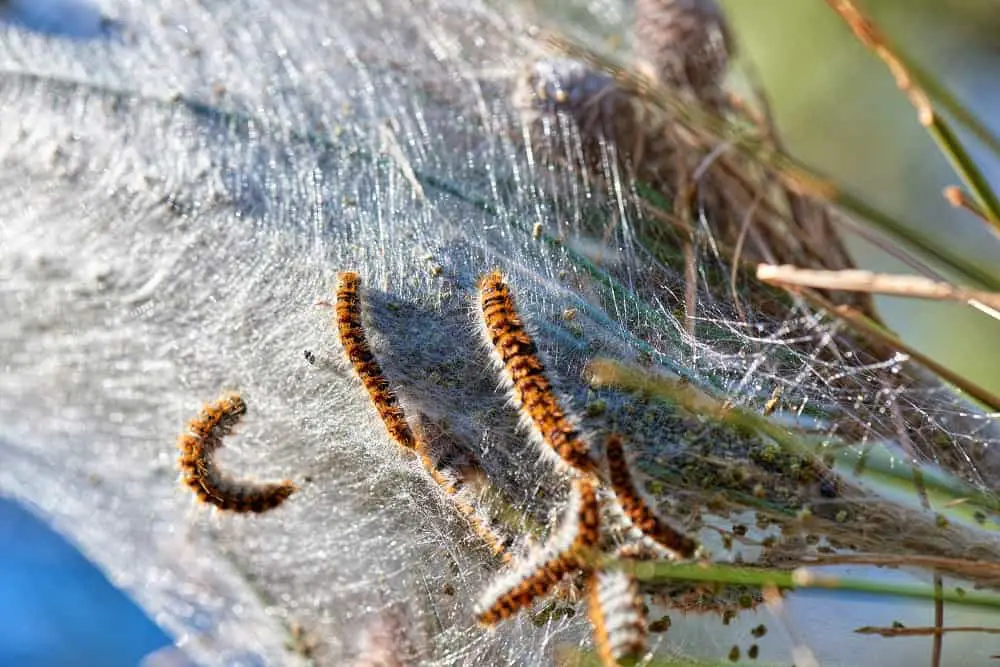
What to do if you get in direct contact with a pine processionary caterpillar
As I mentioned above, different people react in different ways when being in touch with the pine processionary caterpillar.
If you only get a mild reaction with a rash, it can often be enough with an antihistamine cream. But if you swell up, the pain is very strong, or you notice respiratory problems, you should definitely seek a doctor as soon as possible.
If your child gets in touch with the pine processionary caterpillar, make sure you go to a doctor straight away. If the child has touched his or her mouth with an infected hand or put a caterpillar in the mouth, make sure you call the emergency number (112) directly so you can talk to a professional while you wait for the ambulance so you can get the right guidance.
If you have small children, teach them at an early age not to touch these creatures and to tell an adult if they see them.
Reflections
The pine processionary caterpillar is probably the only creature in Andalucia that is a true threat to pets and small children. I might be a bit over-protective with Ayla when it comes to them but I find them rather scary and definitely don’t want to gamble.
Yet, I think it’s important not to let them scare you away from hiking and enjoying the outdoors. Make sure you respect them and take the right measures for whenever you go in their territory when they’re out on their processions.
If you live in southern Spain, make sure you spread the information so that more people are aware of the dangers of these small insects.


Thank you for sharing as I had a reaction in my right leg after a walk. Swollen leg and sore to touch, fever and cough. Recovered after a week, but no idea what caused this. I had a red pin type rash on my lower leg. Will watch out for these furry catapillers in future.
I’m sorry to hear about your leg! These guys can be pretty darn mean, so worth being aware. To many more safe adventures!
Thanks for this info. I came back from Portugal 4 weeks ago and am still not recovered. It is only today that I have been advised that it could be the effects of the Caterpillar. I had very painful hives on my chest and started with a cough which developed into the worst Chest infection I’ve ever had with the doctor suggesting I had pneumonia. I had sore throat, eyes and ears, high temperatures, no appetite. 4 weeks on and I still sound congested but my nose is clear. Still coughing slightly, tired and low energy. I get dizzy and lightheaded and have had the worst cluster headaches ever, daily.
Be aware people and stay away from these. I think I will be recovering for a while yet!
I’m so sorry to hear about your reaction! I wish for you to be well soon. Take care!
There is a solution to these insects. ..
It needs co-operation.
1. Early August- spray the trees with bacillus thureingensis. It is a biological treatment not harmful to us. The bacillus produces an enzyme in the gut of the insect that stops its digestion. It fails to use the energy in its feed and thus fails to grow and develop.
2. In July place light traps for moths. Examine the trap each morning to destroy this moth and let others go.
3. Put plastic collars around pine trees stopping foraging and procession via the trunk. The plastic can be filled with water to drown caterpillars. 3. Dig around below the tree to find and destroy the larvae in early summer. Wear protective gear once and wash it in hot water in a bucket or discard it in waste that is burned.
4. See a procession… spray it with hairspray or gel.
Thank you for the insights on this! Just please be cautious if you try to handle them yourself.
We also have them here in Cataluña
Gotta be careful!
Thank you so much for this article! I already heard about this kind of caterpillar, but now that I am planning a roadtrip to the South of Spain, this has not come to my mind yet. We are planning on going to Sierras de Cazorla, Parque Natural Los Alcornocales and Torcal de Antequera (last one I already saw no need to worry). We are going mid October till beginning of November. For the first two, do you think I still need to worry due to the higher temperatures nowadays?
Hi Myrthe, Thank you for your comment and I’m so sorry I’m so slow in replying. There are no caterpillars out at this time of the year, so you don’t need to worry. They usually start popping out in late December or January and last until the summer heat begins.
I’ve been noticing these nests en route from Pamplona Spain along the mountain roads and into Biarittz France 7/12/23 on the way back to the UK; we’re bringing the dog next time so thanks for the info
Oh! That’s early, but I’m not surprised. Enjoy your next trip with your dog and glad I could be to help:)
My neighbour has them in her garden, is she responsable to get them remover?
I’m not sure actually, I would probably ask the Ayuntamiento. If they are not responsible bc it’s privately owned (most likely,) the owner of the house should probably contact a local company that can professionally remove them. I wish you good luck! Thay are scary creatures…
Hi, thank you so much for the information on hiking near Mijas. I’m currently staying there and would like to go on a simple hike. Do you know if those nasty caterpillars are out at the moment?
Hi Rudolf, I have heard people have seen them walking about already, but right now it has been snow in Sierra de Mijas and the weather is very cold. So chances are that they are not around there atm.
Hi again, Rudolf. I just went up on a hike in Sierra de Mijas today, and there are heaps of nests up there, with some pretty darn fat larvae inside, so I would not bring my dog up now.
In any one area, do the processionary caterpillars tend to leave their nest simultaneously or within a short time of each other? Seen 3 lots now in a week and trying to gauge whether all the many other nests around here are likely to empty shortly so I am not on super alert. Can I assume that in a week or so time, all other caterpillars will have left the nests as well and burrowed somewhere safer? Thanks
I can’t say exactly, but in my experience, they are seen in the same area over a long time, usually several weeks/a couple of months. Remember that even when dead (driven over by cars etc) their hairs are still poisonous. I used to have them crawling on the road near my home and they didn’t exactly stop being there throughout the spring. I assume it depends from nest to nest on how well they feed and when they are ready to start on their next life journey.
We live near Huelva and I spotted a line of the little monsters yesterday in our picnic park, I lightly placed some cardboard over them and trod then flat. Maybe this was a bad move as you have explained the hairs are still toxic after they are dead. Someone told me that covering them in oil works?
That might work. I heard spraying them with hairspray too, but I don’t want to recommend anything as any move will be at your own risk. They are some freaky little buggers!
I’m sorry to hear recommendations for killing these naturally occuring creatures. They are part of a complex web of life, part of an ecological system and we can damage that system easily. For example, what small birds that we love to see, eat the moths when they emerge? Best to avoid the caterpillars, keep our hounds close and marvel at what nature provides for us to see.
I totally get where you come from, I’m not a fan of disturbing natural eco systems in any way. The reason there is pest control on these caterpillars is not because they harm dogs or people. It’s actually because their numbers just raise and raise every year as there aren’t enough birds to keep numbers to a normal rate and they basically eat up and kill the pine forests. That said, it seems like the areas that have had devastating forest fires also killed a lot of moths, so there are no nests in those forests (though also only a few live pine trees). At the end of the day, it’s always human interaction that create unbalance in nature and is the source of what we call “a pest” of bugs/animals.
I live in Arriate. Me and a friend were walking across a railing line yesterday . We were around two km from Arriate. We saw one of the dangerous caterpillars on the railway track around 5.30 evening on 13 Feb 2023 . I was shocked as there are no pine trees anywhere around that area
Why was in on the track. I was so afraid. Now I’m afraid to go walking in that area ever again. My friend who’s Spanish said their not dangerous. I insisted they are. He just said I was over reacting. Can’t believe how ignorant people are. He’s lived there all he’s life and goes out walking all the time and had no idea they were dangerous. I still think he thinks in overreacting. I won’t be going back that area in campo. Strange thing there was only one. It was on the line. It was definitely a processionary caterpillar. We had high winds that week. Could it have blown there or could it of had a nest underground on train track.
Hi Pipa, I can’t say for sure what you saw, but there is another type of caterpillar that looks very similar and don’t live in pine trees. They also don’t walk in prosseccions, so if there are no pine trees around, it is very likely that your friend is right and it wasn’t dangerous. A lot of people don’t see the difference and kill the wrong ones (which aren’t a pest and instead are important for the eco system). To be honest, I wouldn’t know the difference if I saw them, but if I walked with my dog, I would make sure he stayed away from then, but I’d likely not panic if there are no pine forest or trees in sight.
We saw active Pine Processionary caterpillars on their trees up at Calar Alto (the Observatory) yesterday, 11th Feb, with some snow patches still on the ground nearby.
Thanks for the headsup!
Hi thanks for the article. I just noticed that you list the emergency number as ‘122’… it is actually 112.
Thank you so much for the heas up! That was a pretty bad typo. I’ve edited it now:)